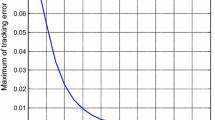Abstract
Feedforward control based on an accurate dynamic model is an effective approach to reduce the dynamic effect of the robot and improve its performance. However, due to the complicated work environment with considerable uncertainty, it is difficult to obtain a high-precision dynamic model of the robot, which severely deteriorates the achievable control performance. This paper proposes an iterative learning method to accurately design the industrial feedforward controller and compensate for the external uncertain dynamic load of the robot. Based on a standard dynamic model, a complete linear feedforward controller is presented. An iterative design strategy is given to iteratively update the feedforward controller by combining the Moore-Penrose Inverse and the PID learning rate. Experiments are carried out on a 5-DOF industrial hybrid robot to validate the effectiveness of the proposed iterative learning method. The experiment results illustrate that the industrial feedforward controller can rapidly converge to the optimal controller and significantly improve the servo performance by using the proposed method. This paper provides an effective method for applying iterative learning control to an unopened industrial control system. It is very useful for the practical control of hybrid robots in industrial field.
Similar content being viewed by others
References
Huang T, Wang M, Yang S, et al. Force/motion transmissibility analysis of six degree of freedom parallel mechanisms. J Mech Robot, 2014, 6: 031010
Kang X, Dai J S. Relevance and transferability for parallel mechanisms with reconfigurable platforms. J Mech Robot, 2019, 11: 031012
Wu J, Wang J, Wang L, et al. Dynamics and control of a planar 3-DOF parallel manipulator with actuation redundancy. Mech Mach Theor, 2009, 44: 835–849
Li Z Y, Zhao D J, Zhao J S. Structure synthesis and workspace analysis of a telescopic spraying robot. Mech Mach Theor, 2019, 133: 295–310
Zhao Y, Gao F. Dynamic performance comparison of the 8PSS redundant parallel manipulator and its non-redundant counterpart—The 6PSS parallel manipulator. Mech Mach Theor, 2009, 44: 991–1008
Rushworth A, Axinte D, Raffles M, et al. A concept for actuating and controlling a leg of a novel walking parallel kinematic machine tool. Mechatronics, 2016, 40: 63–77
Lu Y, Dai Z. Dynamics model of redundant hybrid manipulators connected in series by three or more different parallel manipulators with linear active legs. Mech Mach Theor, 2016, 103: 222–235
Wu J, Yu G, Gao Y, et al. Mechatronics modeling and vibration analysis of a 2-DOF parallel manipulator in a 5-DOF hybrid machine tool. Mech Mach Theor, 2018, 121: 430–445
Shang W, Cong S. Nonlinear computed torque control for a highspeed planar parallel manipulator. Mechatronics, 2009, 19: 987–992
Yang X, Liu H, Xiao J, et al. Continuous friction feedforward sliding mode controller for a TriMule hybrid robot. IEEE/ASME Trans Mechatron, 2018, 23: 1673–1683
Matsubara A, Nagaoka K, Fujita T. Model-reference feedforward controller design for high-accuracy contouring control of machine tool axes. CIRP Ann, 2011, 60: 415–418
Veronesi M, Visioli A. Automatic tuning of feedforward controllers for disturbance rejection. Ind Eng Chem Res, 2014, 53: 2764–2770
Lipiński K. Modeling and control of a redundantly actuated variable mass 3RRR planar manipulator controlled by a model-based feedforward and a model-based-proportional-derivative feedforward-feedback controller. Mechatronics, 2016, 37: 42–53
Liu H, Huang T, Chetwynd D G, et al. Stiffness modeling of parallel mechanisms at limb and joint/link levels. IEEE Trans Robot, 2017, 33: 734–741
Wu J, Wang J, You Z. An overview of dynamic parameter identification of robots. Robot Com-Int Manuf, 2010, 26: 414–419
Shang W, Cong S, Kong F. Identification of dynamic and friction parameters of a parallel manipulator with actuation redundancy. Mechatronics, 2010, 20: 192–200
Bukkems B, Kostic D, de Jager B, et al. Learning-based identification and iterative learning control of direct-drive robots. IEEE Trans Contr Syst Technol, 2005, 13: 537–549
Wu J, Han Y, Xiong Z, et al. Servo performance improvement through iterative tuning feedforward controller with disturbance compensator. Int J Mach Tools Manuf, 2017, 117: 1–10
Wang Z, Hu C, Zhu Y, et al. Newton-ILC contouring error estimation and coordinated motion control for precision multiaxis systems with comparative experiments. IEEE Trans Ind Electron, 2017, 65: 1470–1480
Liu Q, Xiao J, Yang X, et al. An iterative tuning approach for feedforward control of parallel manipulators by considering joint couplings. Mech Mach Theor, 2019, 140: 159–169
Li M, Zhu Y, Yang K, et al. Convergence rate oriented iterative feedback tuning with application to an ultraprecision wafer stage. IEEE Trans Ind Electron, 2018, 66: 1993–2003
Kober J, Bagnell J A, Peters J. Reinforcement learning in robotics: A survey. Int J Robot Res, 2013, 32: 1238–1274
Rani P, Liu C, Sarkar N, et al. An empirical study of machine learning techniques for affect recognition in human-robot interaction. Pattern Anal Applic, 2006, 9: 58–69
Pérez D, Quintana Y. A survey on the Weierstrass approximation theory. Divulgac Matemat, 2008, 16: 231–247
Park K H. A study on the robustness of a PID-type iterative learning controller against initial state error. Int J Syst Sci, 1999, 30: 49–59
Zhang B, Wu J, Wang L, et al. Accurate dynamic modeling and control parameters design of an industrial hybrid spray-painting robot. Robot Com-Int Manuf, 2020, 63: 101923
Author information
Authors and Affiliations
Corresponding author
Additional information
This work was supported by the National Key Research and Development Program of China (Grant No. 2017YFE0111300), EU H2020-MSCA-RISE-ECSASDPE (Grant No. 734272), and the National Natural Science Foundation of China (Grant No. 51975321).
Rights and permissions
About this article
Cite this article
Wu, J., Zhang, B., Wang, L. et al. An iterative learning method for realizing accurate dynamic feedforward control of an industrial hybrid robot. Sci. China Technol. Sci. 64, 1177–1188 (2021). https://doi.org/10.1007/s11431-020-1738-5
Received:
Accepted:
Published:
Issue Date:
DOI: https://doi.org/10.1007/s11431-020-1738-5



